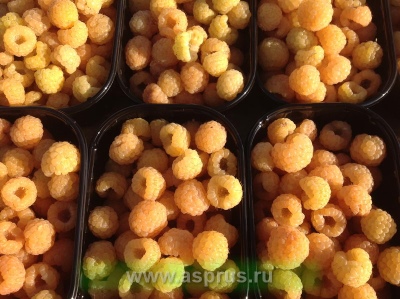
- Authors: Institute of Horticulture and Floriculture in Brzezno, Poland
- Repairability: Yes
- Berry color: bright golden yellow
- Taste: sweet with sourness, pleasant
- Berry weight, g: 5-7 g, maximum - 10 g
- Frost resistance: winter hardy
- Appointment: dessert
- Fruiting period: from July to November
- Synonyms (or Latin name): Porana Rosa
- Transportability: Yes
Raspberry Morning Rosa is a dessert variety that stands out for its unique yellow color. This variety is attracting more and more attention from gardeners every day.
Description of the variety
Morning Dew was bred in Poland, at the Institute of Horticulture and Floriculture. The institution is located in Brzezna. A synonym for the name of the culture is Porana Rosa.
Raspberries have vigorous and erect bushes with a height of 150-170 centimeters. The bushes have spiny shoots covered with short, straight and hard thorns. The foliage is distinguished by slight wrinkling, has a classic bright green color scheme.
Ripening terms
Morning Dew belongs to the remontant raspberry varieties. Fruiting is carried out on the shoots of the current year. The fruiting period stretches from July to November.
Yield
On average, gardeners collect 3 kilograms of berries from one bush, but the figure can be increased by high-quality agricultural technology. And also gardeners note that the largest fruits can be harvested with one-time fruiting.
Berries and their taste
Morning Dew has bright golden yellow berries. Their shape is usually round, spherical. The size is large, the weight in most cases is 5-7 grams, but sometimes it reaches 10 grams. The taste is sweet with a clear sourness, very pleasant. The pulp is firm, but this does not affect the taste.

Growing features
Raspberries of the Morning Rosa variety are not recommended for cultivation in regions where there is constant drought. Such a climate will lead to the fact that the fruits lose sugar and become completely sour.
It is also important to remember that raspberries of this variety grow well, shoots can even intertwine. This cannot be allowed, therefore, when planting, the bushes are placed at a distance of 1.5 m from each other. The width of a row of raspberries should be a maximum of 50 centimeters.
It should also not be forgotten that the shoots will tend to the ground. To prevent the fruits from lying directly on the ground, be sure to tie up the shoots.
Site selection and soil preparation
Morning Dew does not like heat, but it still needs sun. For planting, select a lighted area, you can with partial shadow. Lowlands and hills are not a good solution. The site must be protected from the wind.
For soil, sandy and breathable mixes are ideal. The earth should be well permeable to water. Before planting, it is dug in, adding all the feeding necessary for raspberries to the planting holes.


Pruning
Those shoots that are annuals have certain areas on which fruits will appear, they take up only a third of the shoot. If you want to get a crop twice in the fall, these plots are cut. If the plant is sick, or you just want to improve its characteristics, before wintering, you can carry out a complete pruning, removing all shoots to ground level.

Watering and feeding
Morning Dew loves moisture, so abundant watering is required. Water the plants as soon as the ground dries up. Loosening is not recommended as it can injure the roots. But mulching will be very useful.
The first couple of years after planting, the variety will not need additional feeding. Then he needs nitrogen, phosphorus and potassium. Nitrogen is applied three times: beginning and end of May, mid-June. Then a similar top dressing is carried out annually in the spring.
As nitrogen, you can choose:
urea;
ash;
compost.


Frost resistance and preparation for winter
The variety is generally quite frost-resistant, but may require shelter in some regions. The plant must be removed from the trellis and bent to the ground, covered with a special material. If complete pruning has been carried out, the bushes are covered with straw or spruce branches.

Diseases and pests
Unfortunately, raspberries of this variety can often be affected by various diseases. Most often these are different types of rot. In order to prevent a jump in the disease, regularly thin out the plantings, feed and water the crop, carry out preventive treatments with fungicides.
The most common pests are aphids, raspberry beetles. You can get rid of them using folk and chemical methods. Insecticides are not used until harvest. Often the Morning Dew is attacked by slugs. To make the pest go away, you can set traps and sprinkle spruce needles in the raspberry patch.

Unfortunately, raspberries, like other plants, do not bypass various diseases and pests. Only armed with the knowledge and the necessary means for this, you can cope with such troubles. To help the plant, it is very important to be able to recognize the disease in time and begin timely treatment.
Reproduction
Most often, Morning Dew is propagated by root shoots, since this variety gives a lot of it.In early April, the sprouts reach 15 centimeters. They can be dug up and planted immediately.
Breeding can be done in the fall. Lignified cuttings 25-30 cm long are taken after pruning, placed in moistened sand and put in a cool place for the winter. In early February, the stalk is taken out, the cut is slightly scraped and placed in water, where a teaspoon of honey was previously dissolved. Roots will appear in early March. The seedlings will need to be planted in separate containers and wait for May. This month, they can be rebuilt in a permanent location.








































































